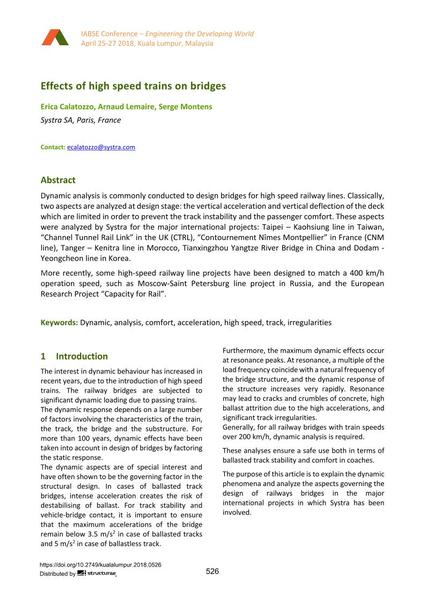Effects of high speed trains on bridges

|
|
|||||||||||
Bibliographic Details
| Author(s): |
Erica Calatozzo
(Systra SA, Paris, France)
Arnaud Lemaire (Systra SA, Paris, France) Serge Montens (Systra SA, Paris, France) |
||||
|---|---|---|---|---|---|
| Medium: | conference paper | ||||
| Language(s): | English | ||||
| Conference: | IABSE Conference: Engineering the Developing World, Kuala Lumpur, Malaysia, 25-27 April 2018 | ||||
| Published in: | IABSE Conference Kuala Lumpur 2018 | ||||
|
|||||
| Page(s): | 526-533 | ||||
| Total no. of pages: | 8 | ||||
| DOI: | 10.2749/kualalumpur.2018.0526 | ||||
| Abstract: |
Dynamic analysis is commonly conducted to design bridges for high speed railway lines. Classically, two aspects are analyzed at design stage: the vertical acceleration and vertical deflection of the deck which are limited in order to prevent the track instability and the passenger comfort. These aspects were analyzed by Systra for the major international projects: Taipei – Kaohsiung line in Taiwan, “Channel Tunnel Rail Link” in the UK (CTRL), “Contournement Nîmes Montpellier” in France (CNM line), Tanger – Kenitra line in Morocco, Tianxingzhou Yangtze River Bridge in China and Dodam - Yeongcheon line in Korea. More recently, some high-speed railway line projects have been designed to match a 400 km/h operation speed, such as Moscow-Saint Petersburg line project in Russia, and the European Research Project “Capacity for Rail”. |
||||
| Keywords: |
acceleration comfort track analysis dynamic high speed irregularities
|
||||
